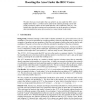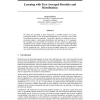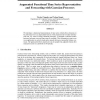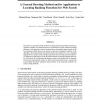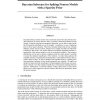NIPS
2007
15 years 2 months ago
2007
A novel approach to measure the interdependence of two time series is proposed, referred to as “stochastic event synchrony” (SES); it quantifies the alignment of two point pr...
NIPS
2007
15 years 2 months ago
2007
Clustering is often formulated as the maximum likelihood estimation of a mixture model that explains the data. The EM algorithm widely used to solve the resulting optimization pro...
103
click to vote
NIPS
2007
15 years 2 months ago
2007
We show that any weak ranker that can achieve an area under the ROC curve slightly better than 1/2 (which can be achieved by random guessing) can be effi
98
Voted
NIPS
2007
15 years 2 months ago
2007
The classical hypothesis, that bottom-up saliency is a center-surround process, is combined with a more recent hypothesis that all saliency decisions are optimal in a decision-the...
NIPS
2007
15 years 2 months ago
2007
We utilize the ensemble of trees framework, a tractable mixture over superexponential number of tree-structured distributions [1], to develop a new model for multivariate density ...
122
click to vote
NIPS
2007
15 years 2 months ago
2007
We construct a biologically motivated stochastic differential model of the neural and hemodynamic activity underlying the observed Blood Oxygen Level Dependent (BOLD) signal in Fu...
57
Voted
NIPS
2007
15 years 2 months ago
2007
We introduce a functional representation of time series which allows forecasts to be performed over an unspecified horizon with progressively-revealed information sets. By virtue...
NIPS
2007
15 years 2 months ago
2007
Over the past few years, the notion of stability in data clustering has received growing attention as a cluster validation criterion in a sample-based framework. However, recent w...
NIPS
2007
15 years 2 months ago
2007
We present a general boosting method extending functional gradient boosting to optimize complex loss functions that are encountered in many machine learning problems. Our approach...
108
Voted
NIPS
2007
15 years 2 months ago
2007
Generalized linear models are the most commonly used tools to describe the stimulus selectivity of sensory neurons. Here we present a Bayesian treatment of such models. Using the ...

